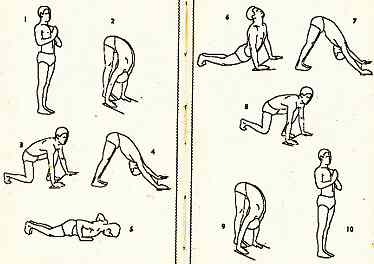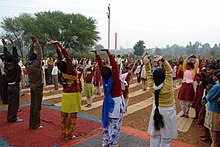Sun Salutation

Sun Salutation, also called Surya Namaskar or Salute to the Sun.
The precise origins of the Sun Salutation are uncertain, but the sequence was made popular in the early 20th century by
Etymology and origins

The name Surya Namaskar is from the Sanskrit सूर्य Sūrya, "Sun" and नमस्कार Namaskāra, "Greeting" or "Salute".[7] Surya is the Hindu demigod of the sun.[8] This identifies the Sun as the soul and source of all life.[9] Chandra Namaskara is similarly from Sanskrit चन्द्र Chandra, "Moon".[10]
The origins of the Sun Salutation are vague; Indian tradition connects the 17th century saint Samarth Ramdas with Surya Namaskara exercises, without defining what movements were involved.[11] In the 1920s, Bhawanrao Shriniwasrao Pant Pratinidhi, the Rajah of Aundh, popularized and named the practice, describing it in his 1928 book The Ten-Point Way to Health: Surya Namaskars.[5][6][12][13] It has been asserted that Pant Pratinidhi invented it,[14] but Pant stated that it was already a commonplace Marathi tradition.[15]
Ancient but simpler Sun salutations such as
The yoga
The historian of modern yoga
Description

The Sun Salutation is a sequence of around twelve
In
A typical[a] Sun Salutation cycle is:
Pranamasana |
Hasta Uttanasana |
 3. Uttanasana |
||
 12: Back to 1 |
 4. Anjaneyasana | |||
 11. Hasta Uttanasana |
Adho Mukha Svanasana
| |||
 10. Uttanasana |
Ashtanga Namaskara
| |||
 9. Anjaneyasana, opposite foot |
 8. Adho Mukha Svanasana |
Urdhva Mukha Shvanasana |
Mantras
In some yoga traditions, each step of the sequence is associated with a
| Step (Asana) |
Mantra (name of Surya)[32] |
Translation: Om, greetings to the one who ...[32] |
|---|---|---|
| Tadasana | ॐ मित्राय नमः Oṃ Mitrāya Namaḥ | is affectionate to all |
Urdhva Hastasana |
ॐ रवये नमः Oṃ Ravaye Namaḥ | is the cause of all changes |
Padahastasana |
ॐ सूर्याय नमः Oṃ Sūryāya Namaḥ | induces all activity |
Anjaneyasana |
ॐ भानवे नमः Oṃ Bhānave Namaḥ | diffuses light |
Parvatasana |
ॐ खगाय नमः Oṃ Khagāya Namaḥ | moves in the sky |
| Ashtanga Namaskara | ॐ पूष्णे नमः Oṃ Pūṣṇe Namaḥ | nourishes all |
| Bhujangasana | ॐ हिरण्यगर्भाय नमः Oṃ Hiraṇya Garbhāya Namaḥ | contains the golden rays |
Parvatasana |
ॐ मरीचये नमः Oṃ Marīcaye Namaḥ | possesses raga |
Ashva Sanchalanasana |
ॐ आदित्याय नमः Oṃ Ādityāya Namaḥ | is son of Aditi |
Padahastasana |
ॐ सवित्रे नमः Oṃ Savitre Namaḥ | produces everything |
Urdhva Hastasana |
ॐ अर्काय नमः Oṃ Arkāya Namaḥ | is fit to be worshipped |
| Tadasana | ॐ भास्कराय नमः Oṃ Bhāskarāya Namaḥ | is the cause of lustre |
Indian tradition associates the steps with
| Step (Asana) | Chakra[34] | Breathing | |
|---|---|---|---|
| Tadasana | ॐ ह्रां Oṃ Hrāṁ | Anahata (heart) | exhale |
Urdhva Hastasana |
ॐ ह्रीं Oṃ Hrīṁ | Vishuddhi (throat) |
inhale |
Padahastasana |
ॐ ह्रूं Oṃ Hrūṁ | Svadhisthana (sacrum) |
exhale |
Ashva Sanchalanasana |
ॐ ह्रैं Oṃ Hraiṁ | Ajna (third eye) | inhale |
Parvatasana |
ॐ ह्रौं Om Hrauṁ | Vishuddhi (throat) |
exhale |
| Ashtanga Namaskara | ॐ ह्रः Oṃ Hraḥ | Manipura (solar plexus) | suspend |
| Bhujangasana | ॐ ह्रां Oṃ Hrāṁ | Svadhisthana (sacrum) |
inhale |
Parvatasana |
ॐ ह्रीं Oṃ Hrīṁ | Vishuddhi (throat) |
exhale |
Ashva Sanchalanasana |
ॐ ह्रूं Oṃ Hrūṁ | Ajna (third eye) | inhale |
Padahastasana |
ॐ ह्रैं Oṃ Hraiṁ | Svadhisthana (sacrum) |
exhale |
Urdhva Hastasana |
ॐ ह्रौं Oṃ Hrauṁ | Vishuddhi (throat) |
inhale |
| Tadasana | ॐ ह्रः Oṃ Hraḥ | Anahata (heart) | exhale |
Variations
Inserting other asanas
Many variations are possible. For example, in Iyengar Yoga the sequence may intentionally be varied to run Tadasana, Urdhva Hastasana, Uttanasana, Adho Mukha Svanasana,
Chandra Namaskara
Variant sequences named Chandra Namaskar, the Moon Salutation, are sometimes practised; these were created late in the 20th century.
As exercise
The energy cost of exercise is measured in units of metabolic equivalent of task (MET). Less than 3 METs counts as light exercise; 3 to 6 METs is moderate; 6 or over is vigorous. American College of Sports Medicine and American Heart Association guidelines count periods of at least 10 minutes of moderate MET level activity towards their recommended daily amounts of exercise.[40][41] For healthy adults aged 18 to 65, the guidelines recommend moderate exercise for 30 minutes five days a week, or vigorous aerobic exercise for 20 minutes three days a week.[41]
The Sun Salutation's energy cost ranges widely according to how energetically it is practised, from a light 2.9 to a vigorous 7.4 METs. The higher end of the range requires transition jumps between the poses.[c][40] Practitioners accustomed to Sun Salutation can find performing the sequence an "exhilarating process".[3]
Muscle usage
A 2014 study indicated that the muscle groups activated by specific asanas varied with the skill of the practitioners, from beginner to instructor. The eleven asanas in the Sun Salutation sequences A and B of
In culture

The founder of
In 2019, a team of mountaineering instructors from Darjeeling climbed to the summit of Mount Elbrus and completed a Sun Salutation there at 18,600 feet (5,700 m), claimed as a world record.[46]
See also
Notes
- ^ As shown in the Indira Gandhi Airport sculpture, above.
- ^ The Bījā mantras are sounds, not translatable words.[35]
- ^ Haskell, curious about the wide range of METs in Sun Salutation, repeated the study (Mody) which gave the highest value; using "transition jumps, and full pushups", he obtained "agreement" with 6.4 METs.[41]
- Caturanga Dandasana
References
- ^ "Surya Namaskara Salute to the Sun". Yoga in Daily Life. Retrieved 26 September 2022.
- ^ Singh, Kritika. Sun Salutation: Full step by step explanation. Surya Namaskar Organization. Archived from the original on 21 December 2021. Retrieved 31 January 2024.
- ^ ISBN 978-0-89281-999-7.
- ^ MacMullen, Jane (1988). "Ashtanga Yoga". Yoga Journal. September/October: 68–70.
- ^ J. M. Dent and Sons. pp. 113–115 and whole book.
The ten positions of a Namaskar are repeated here and may be detached without damaging the book. The pages are perforated for easy removal.
- ^ a b c Singleton 2010, pp. 180–181, 205–206.
- ^ a b c Mehta 1990, pp. 146–147.
- ISBN 978-0-14-341421-6.
- ISBN 978-81-8382-049-3.
- ISBN 978-81-7041-293-9.
- Sadhana.
- ^ S. P. Sen, Dictionary of National Biography; Institute of Historical Studies, Calcutta 1972 Vols. 1–4; Institute of Historical Studies, Vol 3, page 307
- ^ Alter 2000, p. 99.
- ^ Alter 2004, p. 163.
- ^ Singleton 2010, p. 124.
- ^ Murugan, Chillayah (13 October 2016). "Surya Namaskara — Puranic origins of Valmiki Ramayana in the Mumbai Court order on Surya Namaskar for Interfaith discrimination and curtailment of fundamental rights". The Milli Gazette-Indian Muslim Newspaper. Retrieved 13 October 2016.
- ^ sanskrit.safire.com, Aditya Hrudayam with English translation
- ^ Translation of Ramayana by Griffith
- ^ Mujumdar 1950.
- ^ Alter 2004, p. 23.
- ^ a b c Goldberg 2016, pp. 329–331.
- ^ Mohan, A. G.; Mohan, Ganesh (29 November 2009). "Memories of a Master". Yoga Journal.
- ^ Anderson, Diane (9 August 2010). "The YJ Interview: Partners in Peace". Yoga Journal.
- ^ a b c Sjoman 1999, p. 54.
- ^ Bharadwaj, S. (1896). Vyayama Dipika | Elements of Gymnastic Exercises, Indian System. Bangalore: Caxton Press. pp. Chapter 2.
- ^ a b Singleton 2010, p. 175-210.
- ^ Singleton 2010, p. 180.
- ISBN 978-0-86547-749-0.
- ^ Ramaswami 2005, pp. 213–219.
- ^ Vishnudevananda 1988.
- ^ a b c Hughes, Aimee. "Sun Salutation A Versus Sun Salutation B: The Difference You Should Know". Yogapedia.
- ^ a b c "Surya Namaskara". Divine Life Society. 2011. Retrieved 19 July 2019.
- ^ a b Omar, Shazia (27 December 2016). "Sonic salutations to the sun". Daily Star.
- ^ a b c Hardowar, Radha (June 2018). "Surya Namaskar" (PDF). Shri Surya Narayan Mandir.
- ^ Woodroffe, Sir John (2009) [1919]. ŚAKTI AND ŚĀKTA ESSAYS AND ADDRESSES ON THE ŚĀKTA TANTRAŚĀSTRA (3rd ed.). Celephaïs Press. p. 456.
ŚAKTI AS MANTRA intoned in the proper way, according to both sound (Varṇ a) and rhythm (Svara). For these reasons, a Mantra when translated ceases to be such, and becomes a mere word or sentence. By Mantra, the sought-for (Sādhya) Devatb appears, and by Siddhi therein it had vision of the three worlds. As the Mantra is in fact Devatā, by practice thereof this is known. Not merely do the rhythmical vibrations of its sounds regulate the unsteady vibrations of the sheaths of the worshipper, but therefrom the image of the Devatā, appears. As the Bṛ had-Gandharva Tantra says (Ch. V):— Śrinu devi pravakṣ yāmi bījānām deva-rūpatām Mantroccāranamātrena deva-rūpam prajāyate.
- ^ a b Ferretti, Andrea; Rea, Shiva (1 March 2012). "Soothing Moon Shine: Chandra Namaskar". Yoga Journal.
- ^ Mirsky, Karina. "A Meditative Moon Salutation". Yoga International. Retrieved 23 July 2019.
- ^ Venkatesan, Supriya. "Moon Salutations". Yoga U. Retrieved 23 July 2019.
- ^ Tomlinson, Kirsty. "Moon Salutation sequence". Ekhart Yoga. Retrieved 23 July 2019.
- ^ PMID 27433961. The review examined 17 studies, of which 10 measured the energy cost of yoga sessions.
- ^ PMID 17671237.
- PMID 25146071.
- ^ Bullock, B. Grace (2016). "Which Muscles Are You Using in Your Yoga Practice? A New Study Provides the Answers". Yoga U. Retrieved 22 July 2019.
- ^ "Destination Delhi". Indian Express. 4 September 2010.
- ^ "Surya Namaskar in the words of Sri K. Pattabhi Jois". Discover the Purpose. Retrieved 20 July 2019.
- ^ "Suryanamaskar and Yoga Atop of Mountain Summit (18600 Feet)". World Records India. 3 October 2019. Archived from the original on 3 October 2019.
Sources
- ISBN 978-0-812-23556-2.
- OCLC 53483558.
- OCLC 926062252.
- Mehta, Silva; Mehta, Mira; Mehta, Shyam (1990). ISBN 978-0863184208.)
{{cite book}}: CS1 maint: multiple names: authors list (link - Mujumdar, Dattatraya Chintaman, ed. (1950). Encyclopedia of Indian Physical Culture: A Comprehensive Survey of the Physical Education in India, Profusely Illustrating Various Activities of Physical Culture, Games, Exercises, Etc., as Handed Over to Us from Our Fore-fathers and Practised in India. Good Companions.
- ISBN 978-1-56924-402-9.
- ISBN 978-0-19-974598-2.
- ISBN 81-7017-389-2.
- OCLC 32442598.
External links
- Dep't of Posts, Gov't of India releases stamps on Surya Namaskara on International Yoga Day2016.


